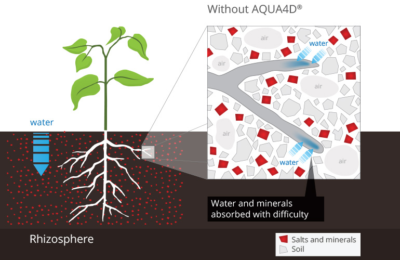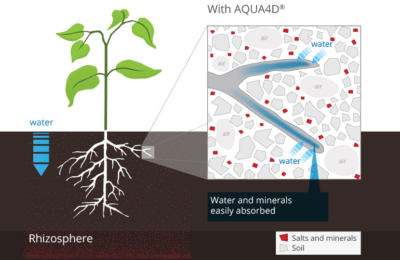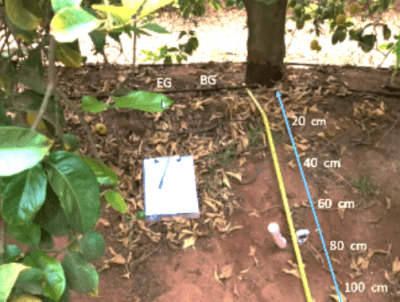The “finca” contains a 24ha plantation of navelina orange trees near Seville, Spain. Located in the picturesque Andalusian countryside, there’s no shortage of sun here but problems have accumulated due to another resource: water. They use river water for irrigation – poor quality water with very high levels of chlorides, sodium and sulfates. Over the years, this has led to debilitating salinity problems (EC measurement of 4.7), affecting yields and fruit size.
“This was causing us a lot of problems on our plantation,” says the farm owner. “The trees weren’t growing well, the leaves were turning yellow, the branches were drying out… and production was suffering year after year in a big way.”
Seeking a lasting and sustainable solution to this issue, the producer installed an AQUA4D® system and monitored the effect on soil salinity and yields over the following seasons.
This water-smart innovation was easily installed onto the existing irrigation system, and two adjacent plots were monitored: one control (untreated), and one plot treated by AQUA4D®. Measurements were taken at regular intervals at different depths. Based on various previous projects in similar conditions, the expectation was that soil EC would reduce at all depths to tolerable levels for the plant.
How does AQUA4D® efficiently combat salinity?
Over time, crystallizing salts block the upper part of the soil, creating water penetration problems. Salts also crystallize in the root zone, blocking entrance to the finer pores, reducing the capacity of the soil to store and retain water. Treatment by AQUA4D® helps dissolve these crystallizations, opening up the finer soil pores. This both increases water retention in the soil, allowing for less frequent irrigation, and also leaches harmful salts down out of harm’s away. Free from the shackles of salinity, the plant can improve its performance and thus increase productivity and fruit growth.
Move the slider here from Left to Right:


This is precisely what was observed here in Seville: the orange crops were able to develop with better nutrient supply, no longer held back by the poor-quality water. “The appearance of the trees evolved radically,” says the grower. “You could see the difference even without measuring equipment or anything; it just jumped out at you. Of course, the best thing was the results. In the treated area, 22% more kilos were obtained than in the control area!”
Indeed, analysis of the results show just how positively the trees reacted to this new lease of life, with each tree producing an average of 13.4 kg more oranges compared to the control plots. There were also individual differentiations in fruit size, showing consistently larger fruit diameters in the AQUA4D® plot:
“In this season the results are still evident and everyone who visits us appreciates the difference at first sight,” he adds.
Enrique Rebaza was the agronomist overseeing the project: “By using AQUA4D over 12 months we were able to significantly reduce the electroconductivity of the soil at different depths and keep the chloride level in adequate ranges well below the control,” he comments. “This allowed us to have a campaign this year with less salt stress and better availability of nutrients.”
Water savings and climate adaptation
With droughts and climate change expected to severely affect water access in the south of Spain over the coming years, technology like AQUA4D can solve salinity while also using less water for irrigation at the same time.
Hence what started for this orange grower as an endeavor to solve their salinity issue has given them increased yields, water savings, and equipped them with a sustainable technology offering climate resilience for many years to come.
Detailed results:

Electroconductivity measurements:

Spain
Water treatment
Salinity
“The appearance of the trees evolved radically. You could see the difference even without measuring equipment or anything; it just jumped out at you. Of course, the best thing was the results. In the treated area, 22% more kilograms were obtained than in the control area!”
Animation: How AQUA4D® manages soil salinity and allows irrigation with saline water




